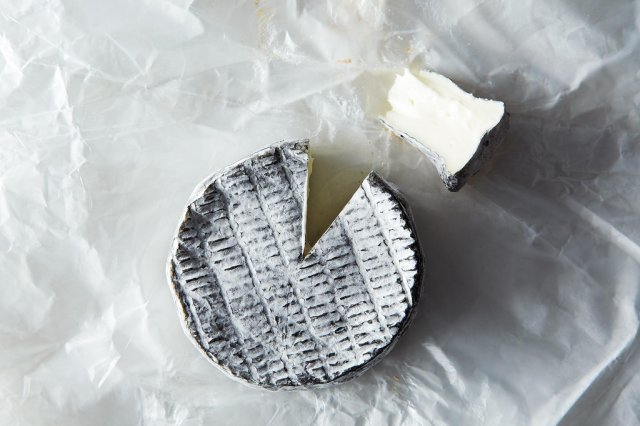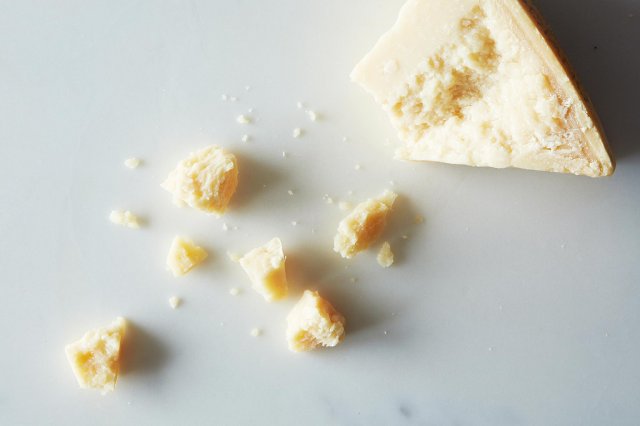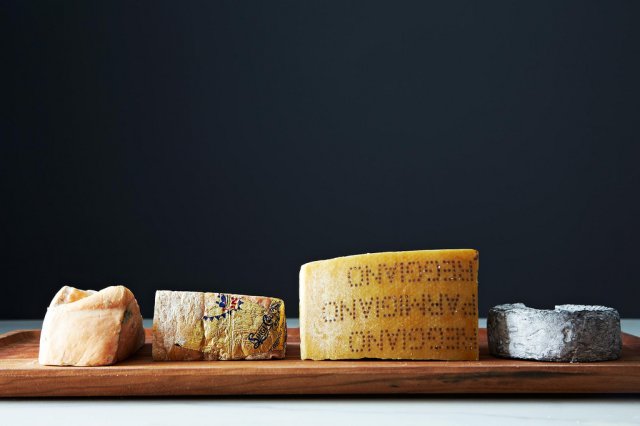Pair your cheese with cider
Portland, Oregon is full of surprises: Turn a corner and you’re in the middle of the largest wild park in the country, ask for directions and you’ll leave the conversation with a recommendation for the best local cider, and order “omakase” at what looks to be a sushi bar and you may end up with a plate of cheese.
Chizu has all the fixings of a classic Japanese sushi counter with floating origami cranes and bar-seating facing glass cases of food—except rather than sashimi, the cases are filled with Comté, soft Oregon goat cheeses, and German Sternschnuppe. Name a price and the cheese mongers behind the counter will arrange a variety of cheeses with nuts, honey, and chutney. Steve Jones, the owner of Chizu and its sister restaurant Cheese Bar, shares with us 10 foolproof ways to put together an elegant, delicious cheese plate at home:
1. Choose your board wisely
When selecting a cheese board, Steve recommends using organic materials like wood, slate, or ceramic tile. In his own words, “It makes it look more alive if it’s on something organic. If the cheese is on porcelain, it looks cold,” which can lead to an univiting plate. Steve says, “It’s true that you eat with your eyes first.”
More from Food52:
- 5 Tips for Stress-Free, Budget-Friendly Entertaining
- How to Never Overcook Salmon (or Other Fishes) Again
- 5 Variations on Avocado Toast
2. Set out an odd number of cheeses
Steve says that he always chooses an odd number of cheeses simply because he’s found that that “an odd number of cheeses looks better than even number.” He usually chooses either three or five cheeses for any given plate, and rarely more than seven. “At that point,” he explains, “you’re going to lose people.”
3. Make sure you represent the ‘Holy Trinity’

If you’re making the minimum-sized cheese board, make sure you represent what Steve refers to as the “Holy Trinity” of cheeses: cow, goat, and sheep. Once you have that baseline, you can start getting into more unusual cheeses like water buffalo or soft, stinky blues.
4. Take texture into account

You don’t want every cheese on a board to feel exactly the same—mix it up with some differences in the texture and density. But, Steve adds, when taking into account texture and flavor, flavor wins.
5. Consider the region
Steve recommends to either go “really dorky” and have everything from one region, like an all-Oregon or Pyrenees plate, or try to spread things out and have one from France, England, and Spain for a “quick trip around the world.”
6. Don’t pair your cheese plate with wine
The wine list at Chizu is short—a decision Steve made because he discourages pairing wine with cheese. He says, “The tannins in wine dull the palate with every sip.”
7. But do pair your cheese plate with cider
Cider, on the other hand, is the perfect drink to have with a cheese plate—and beer isn’t so bad, either. Steve says, “With cider and beer, there’s effervescence, so it keeps the palate lively—it’s not being dulled out. With cider, you’ve got the natural components of fruit and apples, which are such a natural pairing with cheese.” Think cheddar and apples—a match made in heaven.
8. Add other elements, like nuts and sauces, to your cheese plate

Tucked between the cheeses I got at Chizu were hazelnuts, honey, dried fruit, and chutney, which Steve explains the monger chooses based on the cheeses on the plate. Steve says that some pairings, like chutney, are traditional with English cheeses and cheddars, and that nuts and honey go well with blue cheeses. Beyond that, feel free to experiment. His personal favorite pairing is cherries with triple-crème cheese, but you can also try citrus with chevre, or even chocolate with blue cheese.
9. Arrange the cheeses from mild to strong, then eat them accordingly
While Steve is hesitant to recommend eating cheeses in a specific way—it’s fun to play around and see what works best for you—he suggests laying out the cheeses on the plate in order from the most mild increasingly to stronger cheeses, ending with a blue. As with wine and beer, eating the cheeses in this order ensures that you aren’t overwhelming your palate with intense flavors before being able to taste the most subtle cheeses.
10. Trust your cheese monger
Depending on how well cheeses are cared for, they can differ from counter to counter. “A really good Stilton,” Steve explains, “can be available, but if it isn’t well cared for, it is not fun to eat.” The solution? Find a cheese monger you trust and let them guide you—they should be able to listen well for what you want and give you what you’re looking for.
But at the end of the day, Steve says, “It’s just cheese. Don’t get overwhelmed.”
This article originally appeared on Food52
-
1. Choose your board wisely
When selecting a cheese board, Steve recommends using organic materials like wood, slate, or ceramic tile. In his own words, “It makes it look more alive if it’s on something organic. If the cheese is on porcelain, it looks cold,” which can lead to an univiting plate. Steve says, “It’s true that you eat with your eyes first.”
More from Food52:
-
2. Set out an odd number of cheeses
Steve says that he always chooses an odd number of cheeses simply because he’s found that that “an odd number of cheeses looks better than even number.” He usually chooses either three or five cheeses for any given plate, and rarely more than seven. “At that point,” he explains, “you’re going to lose people.”
-
3. Make sure you represent the ‘Holy Trinity’

James Ransom/Food52 If you’re making the minimum-sized cheese board, make sure you represent what Steve refers to as the “Holy Trinity” of cheeses: cow, goat, and sheep. Once you have that baseline, you can start getting into more unusual cheeses like water buffalo or soft, stinky blues.
-
4. Take texture into account

James Ransom/Food52 You don’t want every cheese on a board to feel exactly the same—mix it up with some differences in the texture and density. But, Steve adds, when taking into account texture and flavor, flavor wins.
-
5. Consider the region
Steve recommends to either go “really dorky” and have everything from one region, like an all-Oregon or Pyrenees plate, or try to spread things out and have one from France, England, and Spain for a “quick trip around the world.”
-
6. Don’t pair your cheese plate with wine
The wine list at Chizu is short—a decision Steve made because he discourages pairing wine with cheese. He says, “The tannins in wine dull the palate with every sip.”
-
7. But do pair your cheese plate with cider
Cider, on the other hand, is the perfect drink to have with a cheese plate—and beer isn’t so bad, either. Steve says, “With cider and beer, there’s effervescence, so it keeps the palate lively—it’s not being dulled out. With cider, you’ve got the natural components of fruit and apples, which are such a natural pairing with cheese.” Think cheddar and apples—a match made in heaven.
-
8. Add other elements, like nuts and sauces, to your cheese plate

James Ransom/Food52 Tucked between the cheeses I got at Chizu were hazelnuts, honey, dried fruit, and chutney, which Steve explains the monger chooses based on the cheeses on the plate. Steve says that some pairings, like chutney, are traditional with English cheeses and cheddars, and that nuts and honey go well with blue cheeses. Beyond that, feel free to experiment. His personal favorite pairing is cherries with triple-crème cheese, but you can also try citrus with chevre, or even chocolate with blue cheese.
-
9. Arrange the cheeses from mild to strong, then eat them accordingly
While Steve is hesitant to recommend eating cheeses in a specific way—it’s fun to play around and see what works best for you—he suggests laying out the cheeses on the plate in order from the most mild increasingly to stronger cheeses, ending with a blue. As with wine and beer, eating the cheeses in this order ensures that you aren’t overwhelming your palate with intense flavors before being able to taste the most subtle cheeses.
-
10. Trust your cheese monger
Depending on how well cheeses are cared for, they can differ from counter to counter. “A really good Stilton,” Steve explains, “can be available, but if it isn’t well cared for, it is not fun to eat.” The solution? Find a cheese monger you trust and let them guide you—they should be able to listen well for what you want and give you what you’re looking for.
But at the end of the day, Steve says, “It’s just cheese. Don’t get overwhelmed.”